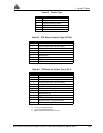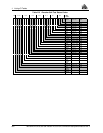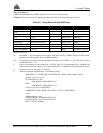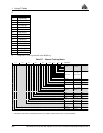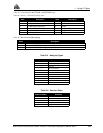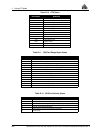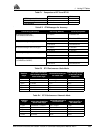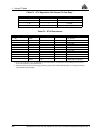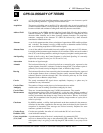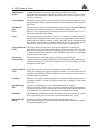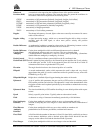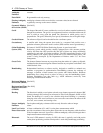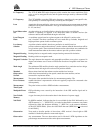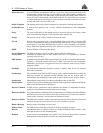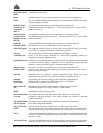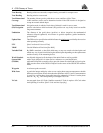
K GPS Glossary of Terms
MiLLennium GPSCard SW Version 4.503/4.52 Command Descriptions Manual Rev 2 267
K GPS Glossary of Terms
ASCII A 7-bit wide serial code describing numbers, upper and lower case characters, special
and non-printing characters. Typically used for textual data.
Acquisition The process of locking onto a satellite’s C/A code and P code. A receiver acquires all
available satellites when it is first powered up, then acquires additional satellites as they
become available and continues tracking them until they become unavailable.
Address Field For sentences in the NMEA standard, the fixed length field following the beginning
sentence delimiter "$" (HEX 24). For NMEA approved sentences, composed of a two
character talker identifier and a three character sentence formatter. For proprietary
sentences, composed of the character "P" (HEX 50) followed by a three character
manufacturer identification code.
Almanac A set of orbit parameters that allows calculation of approximate GPS satellite positions
and velocities. The almanac is used by a GPS receiver to determine satellite visibility
and as an aid during acquisition of GPS satellite signals.
Almanac Data A set of data which is downloaded from each satellite over the course of 12.5 minutes.
It contains orbital parameter approximations for all satellites, GPS to universal standard
time (UTC) conversion parameters, and single-frequency ionospheric model parameters.
Anti-Spoofing Denial of the P-code by the Control Segment is called Anti-Spoofing. It is normally
replaced by encrypted Y-code, [see P-Code and Y-Code]
Attenuation Reduction of signal strength
Azimuth The horizontal direction of a celestial point from a terrestrial point, expressed as the
angular distance from 000° (reference) clockwise through 360°. The reference point is
generally True North, but may be Magnetic North, or Relative (ship's head).
Bearing The horizontal direction of one terrestrial point from another terrestrial point, expressed
as the angular distance from a reference direction, usually measured from 000° at the
reference direction clockwise through 360°. The reference point may be True North,
Magnetic North, or Relative (ship's head).
Carrier The steady transmitted RF signal whose amplitude, frequency, or phase may be
modulated to carry information.
Carrier Phase The number of integer carrier phase cycles between the user and the
Ambiguity satellite at the start of tracking. (Sometimes ambiguity for short)
Carrier Phase These are “accumulated doppler range” (ADR) measurements. They contain
Measurements the instantaneous phase of the signal (modulo 1 cycle) plus some arbitrary number of
integer cycles. Once the receiver is tracking the satellite, the integer number of cycles
correctly accumulates the change in range seen by the receiver. When a “lock break”
occurs, this accumulated value can jump an arbitrary integer number of cycles (this is
called a cycle slip).
Checksum By NMEA standard, a validity check performed on the data contained in the sentences,
calculated by the talker, appended to the message, then recalculated by the listener for
comparison to determine if the message was received correctly. Required for some
sentences, optional for all others.
Circular Error Circular error probable; the radius of a circle such that 50% of a set of events
Probable (CEP) occur inside the boundary.
Coarse Acquisition A pseudorandom string of bits that is used primarily by commercial GPS
(C/A) Code receivers to determine the range to the transmitting GPS satellite. The 1023 chip C/A
code repeats every 1 ms giving a code chip length of 300 m which, is very easy to lock
onto.
K GPS GLOSSARY OF TERMS



